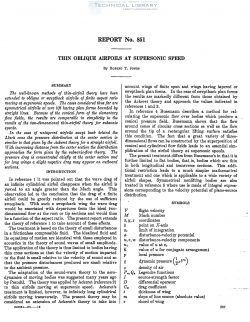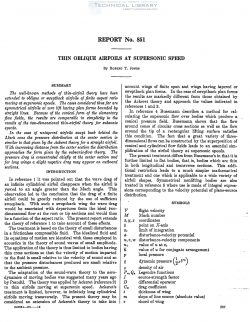naca-report-851

- Version
- 184 Downloads
- 774.90 KB File Size
- 1 File Count
- August 31, 2016 Create Date
- August 31, 2016 Last Updated
National Advisory Committee for Aeronautics, Report - Thin Oblique Airfoils at Supersonic Speed

The well-known methods of thin-aitfoil theory have been
extended to oblique or sioeptback aiij‘o’iIs offinite aspect ratio
moving at supersonic speeds. The cases considered thus far are
symmetrical airfoils at zero lift having plan forms bounded by
straight lines. Because of the conical form of the elementary
flow fields, the results are comparable in simplicity to the
results of the two-dimensional thin—airfoil theory for subsonic
speeds.
In the case of untapered airfoils swept back behind the
lilac-h cone the pressure distribution at the center section is
similar to that given by the Ackeret theory for a straight airfoil.
With increasing distance from the center section the distribution
approaches the form given by the subsonictflow theory. The
pressure drag is concentrated chiefly at the center section and
for long wings a slight negatire drag may appear on outboard
sections.
In reference 1 it was pointed out that the wave drag of
an infinite cylindrical airfoil disappears when the airfoil is
yawed to an angle greater than the Mach angle. This
observation led to the conclusion that the drag of a finite
airfoil could be greatly reduced by the use of sufficient
sweepback. With such a sweptback wing the wave drag
would be associated with departures from the ideal two-
dimensional flow at the. root or tip sections and would thus
be a function of the aspect ratio. The present report extends
the theory of reference 1 to take account of these effects.
The treatment is based on the theory of small disturbances
in a frictionless compressible fluid. The idealized fluid and
its equations of motion are identical with those employed in
acoustics in the theory of sound waves of small amplitude.
The application of the theory is thus limited to bodies having
thin cross sections so that the velocity of motion imparted
to the fluid is small relative to the velocity of sound and so
that the pressure disturbances produced are small relative
to the ambient pressure.
| File | Action |
|---|---|
| naca-report-851 Thin Oblique Airfoils at Supersonic Speed.pdf | Download |
Comment On This Post